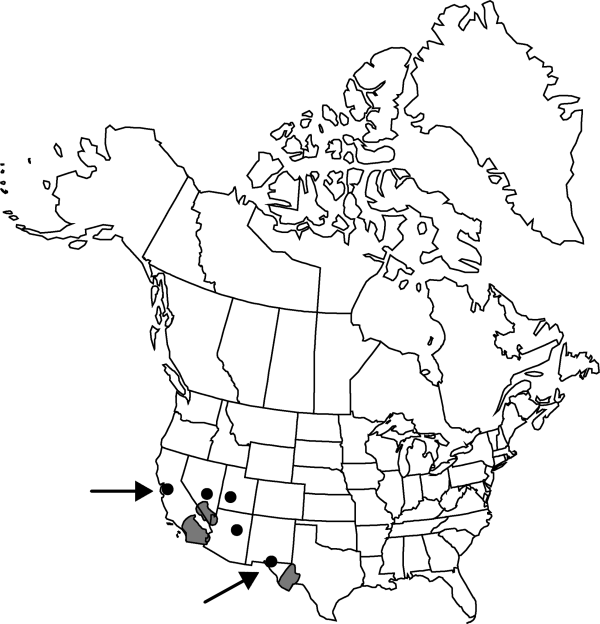Difference between revisions of "Tidestromia suffruticosa"
J. Wash. Acad. Sci. 6: 70. 1916.
FNA>Volume Importer |
FNA>Volume Importer |
(No difference)
| |
Revision as of 20:03, 24 September 2019
Subshrubs, perennial, gray-green, grayish, or sometimes reddish, to 60 cm, canescent, pruinose, or densely lanuginose to glabrate; trichomes completely or partially candelabriform. Stems ascending or decumbent, suffrutescent or suffruticulose, buds commonly present, rarely absent, on stem bases, lanate or densely lanate. Leaves: petiole to 2.5 cm; blade lanceolate, ovate, ovate-oblong, very widely ovate, circular, or reniform, 0.6–4.5 × 0.4–2.7 cm, chartaceous, base cordate, cuneate, lightly attenuate, or oblique. Inflorescences 1–3(–4)-flowered; involucral leaf petiole to 0.9 cm, blade lanceolate, ovate, very widely ovate, circular, or reniform, 0.2–2.7 × 0.2–2.1 cm, chartaceous, base cuneate, cordate, attenuate, or oblique, apex acute or obtuse; involucre on secondary branches formed by connation of involucral leaf petioles, which becomes indurate and adnate with stem or with leaf petiole and stem; bracts widely ovate or widely depressed-ovate, 0.8–1.6 × 0.8–1.6 mm, apex acute or obtuse, crenate, lanuginose distally or glabrous; bracteoles 0.9–1.5 × 0.6–1.4 mm, apex acute or obtuse, lanuginose or glabrous. Flowers 1.7–3 mm; tepals yellowish or yellowish brown, 1.7–2.7 × 0.6–1.3 mm, densely lanuginose to glabrous; staminal cup 0.4–0.9 mm; filaments 0.5–1 mm; anthers 0.5–0.9 mm; pseudostaminodes absent or triangular lobes, 0.1–0.3 mm; ovary 0.3–0.7 × 0.5–0.9 mm; style to 0.1 mm; stigmas 0.2–0.5 mm. Utricles 1–1.8 × 0.8–1.6 mm. Seeds brown-red, 0.9–1.5 × 0.8–1.4 mm.
Distribution

North America, Mexico.
Discussion
Varieties 2 (2 in the flora).
Tidestromia suffruticosa is easily recognized by its perennial, subshrub habit. It varies in density and color of indumentum, number and size of interstaminal appendages, and color and indumentum of tepals.
I. M. Johnston (1943) recognized two varieties of Tidestromia: var. suffruticosa and var. coahuilana. The former has weakly woody stems, hairy flowers, and short-petiolate involucral leaves; var. coahuilana has rigidly woody stems, glabrous flowers, and distinctly petiolate involucral leaves, although he noted that these differences were not always strongly developed. We have found that these characters vary widely within T. suffruticosa and that var. coahuilana is not worthy of recognition.
Tidestromia gemmata was described by I. M. Johnston (1943) as having coarse, very strong taproots, conspicuous large cottony buds (gemmae) borne near the surface of the soil, slightly more woody reddish stems, and thicker more strongly veined leaves. C. F. Reed (1970) further distinguished the species by the lack of pseudostaminodes and prostrate habit. We found that buds on the apex of the caudex are present in all perennial species of Tidestromia but can be absent on many well-collected specimens. Interstaminal appendages vary in number from zero to five. Furthermore, T. gemmata is not prostrate but is ascending or decumbent and there are no taxonomically useful differences with T. suffruticosa in the thickness of the taproot, stem characters, or leaf venation. We treat T. gemmata and T. suffruticosa as conspecific.
Tidestromia suffruticosa includes the distinctive features of T. oblongifolia used by P. C. Standley (1917b) and D. S. Correll and M. C. Johnston (1970). The only taxonomically important character is leaf shape; other characters given by those authors are not taxonomically important. In addition, however, characters of the involucres and distribution serve to distinguish T. oblongifolia as a variety of T. suffruticosa.
Selected References
None.
Key
| 1 | Leaf blades usually ovate (lanceolate, ovate, very widely ovate, or reniform); in fruit, internodes of secondary branches subtending involucres usually well defined and not crowded | Tidestromia suffruticosa var. suffrutico |
| 1 | Leaf blades usually oblong (ovate-oblong, circular, lanceolate, or ovate); in fruit, internodes of secondary branches subtending involucres usually reduced and crowded | Tidestromia suffruticosa var. oblongifol |